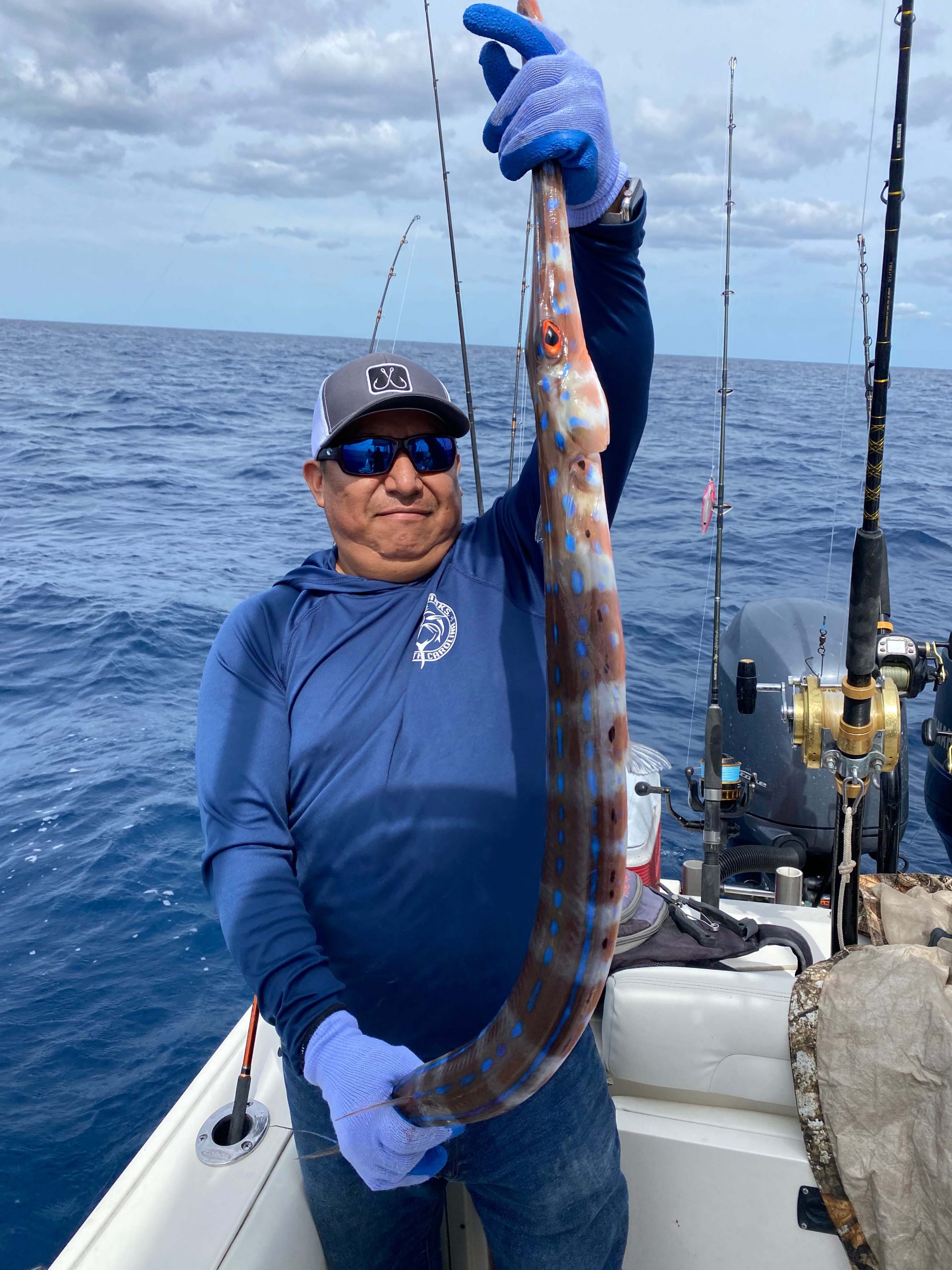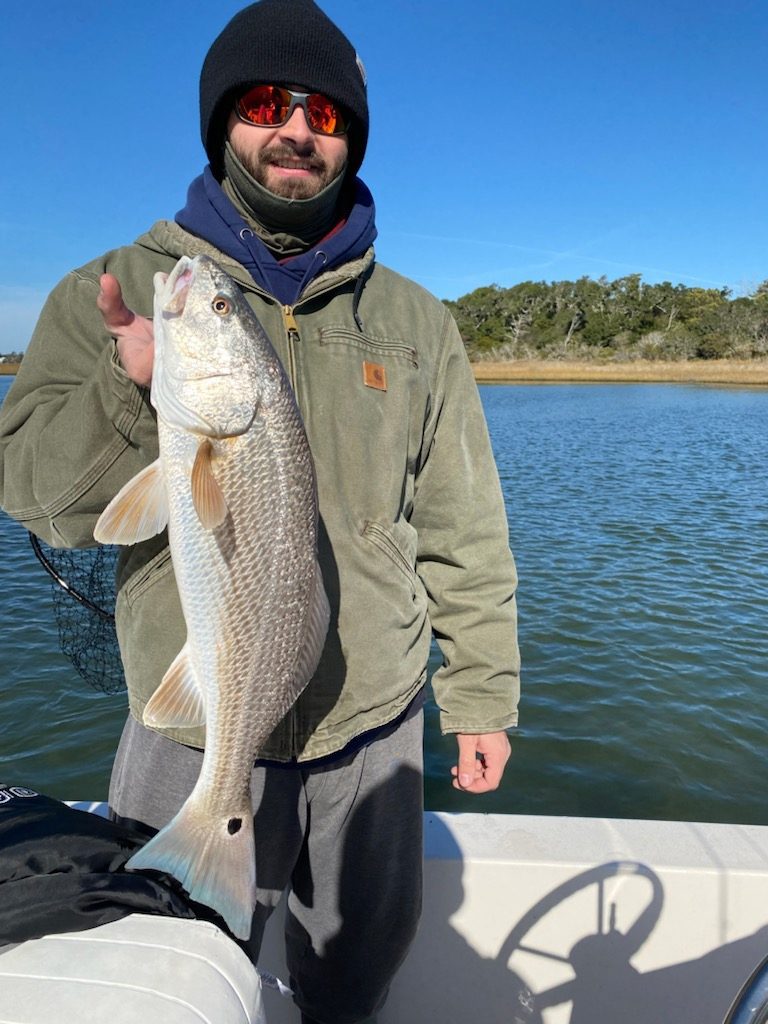Morehead City/Atlantic Beach – April 2022
Spencer, of Chasin’ Tails, reports that speckled trout are still in the area’s creeks, though they are moving around much more than the past couple of cold weather months. Anglers have found most action while focusing on where the bait is staged up, as the trout have been moving from the mouths to the backs of creeks following their forage.
Red drum action has been getting better in both the marshes and some of the mainland creeks.
Sea mullet fishing is in full swing for anglers targeting deeper holes around the inlet with shrimp.
Gray trout have also pushed into this deeper area from the Coast Guard station back into the turning basin.
Bluefish are arriving inshore around the port and out to nearshore areas such as AR-315.
Anglers running off the beach have been focused on bottom fishing. Mixed bags of large black sea bass, triggerfish, and vermilion snapper have made up most of the catch.

Ambrocio Tellez caught this blue spotted cornet on a Blue Water Candy Roscoe jig in 150′ of water out of Bogue Inlet. He was fishing with Capt. Chris Falcone of Spooled Rotten Charters.
Joe, of Carolina Traditions Guide Co., reports that bluefish have been some of the first fish to arrive and will be pushing in in good numbers over the next few weeks.
False albacore are being found by anglers sight-casting with metal jigs around bait balls.
Some early cobia have been landed out in the 80-100’ range. Anglers will be watching for these fish as they slowly migrate up the ledges from the south.
Speckled trout are getting a little tougher to target as they have now moved out of their wintering areas. They spend the next few weeks really moving with the bait until water temperatures start to hold in the 60-64 degree range. At this point, anglers will have success targeting the area’s grass flats.
Red drum are also starting to move back onto marsh banks and grass ledges along the shorelines. In the meantime, anglers are still finding plenty of action back on the shallow, muddy bays.
Daniel, of On Deck Fishing Charters, reports that red drum are becoming more active for anglers looking for topwater action. Some local favorites are Heddon Spooks, Rapala Skitterwalks, and MirrOlure Top Pups in a variety of color patterns. Other baits that will garner strikes in this transition period are gold spoons, Gulp shrimp on 1/4 oz. jig heads, or cut mullet under a popping cork.
Speckled trout are starting to move out of their winter hold-over areas and are now pushed out into creek mouths. Topwater plugs, MirrOlure suspending baits, and soft plastics will all have success as these fish get more aggressive in the next few weeks.
Schools of sea mullet have staged up in deeper holes throughout the inlet area. Anglers have been filling coolers while bottom fishing with shrimp and Betts Spec Rigs.
Chris, of Mount Maker Charters, reports that red drum and speckled trout are getting more active by the day as inshore water temperatures move up. Look for both species in the deeper mainland creeks and edges of the ICW.
Plenty of sea mullet and gray trout have moved into deeper areas from Beaufort Inlet back into the turning basin. Anglers are finding plenty of action fishing classic two-hook bottom rigs with shrimp or Fish Bites artificial bait strips.
Black drum and some sheepshead are holding around the jetties and feeding mostly on shrimp.
Over the next few weeks, expect to see the larger gray trout move in over the nearshore artificial reefs.
Nearshore anglers will also be finding Atlantic bonito, false albacore, and even a few blackfin tuna that always seem sprinkled in throughout the spring.
Justin, of Breakday Charters, reports that sea mullet fishing has been great in the port area for anglers looking for wide open catching action.
Keeper-sized gray trout are also moved into these same deeper holes from the inlet back up past the turning basin. Spec rigs tipped with shrimp or Fish Bites bait strips have worked best.
The larger class of gray trout are off the beach and holding over the nearshore artificial reefs.
Speckled trout are still up in the creeks, but anglers will need to be flexible in following these schools as they transition out with the arrival of bait.
Red drum are pushing inshore to start hunting for crabs. Anglers will find success while targeting the wind-blown marsh banks and docks with cut mullet or soft plastics.
False albacore are starting to move closer to the beach, though most schools are still holding in the 20 mile range.

Ian Gill hooked this 5.7 lb. redfish on a golden bream Zoom fluke in Bogue Sound.
Byron, of Going Bogue Outdoors, reports that wahoo action has been strong for anglers making long runs to the wall of the Gulf Stream (and sometimes further depending on conditions).
Blackfin tuna and a few yellowfin have also been mixed in on trolling trips around Big Rock.
Some early season mahi have been caught around hot water (76-degree range) on hard tide lines offshore.
Bottom fishing anglers have found black sea bass and triggerfish action to be the most accessible catches, with good numbers of fish holding in the 90-120’ range. Vermilion snapper and other various bottom fish are sporadically mixed in the action.
The larger snapper and red porgies have been holding deep (300+’ range).
Woody, of Rigged Right Charters, reports that bottom fishing anglers have found black sea bass to be plentiful in the 10-30 mile range. The deeper edges of that range are also holding good numbers of vermilion snapper and triggerfish.
Gulf Stream trips have been producing some wahoo action for anglers high-speed trolling the temperature breaks. Anglers can expect to see a mixed bag of blackfin tuna and a few yellowfin while on these trolling trips.
Bri, of Oceanana Pier, reports that cooler water temperatures have anglers still finding plenty of dogfish sharks and skates hanging around.
On some days anglers are seeing good runs of sea mullet. Croakers and scattered bluefish are also in the mix.
